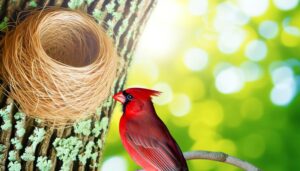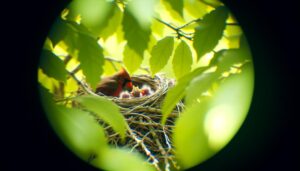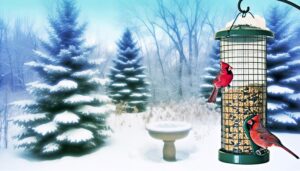Do Cardinals Reuse Their Nest?
Cardinals typically don't reuse their nests. They prefer constructing new ones each breeding season.
Female cardinals weave twigs, leaves, and grass to create well-concealed cup-shaped nests in dense foliage. Ideal nesting sites include shrubs or low tree branches, providing protection against predators and harsh weather.
Cardinals select dogwoods, maples, and pines, with nests usually situated 3 to 10 feet above ground. The meticulous selection of nesting materials and locations reflects their adaptability and commitment to successful breeding.
Continue to explore their nesting behaviors for more fascinating details.
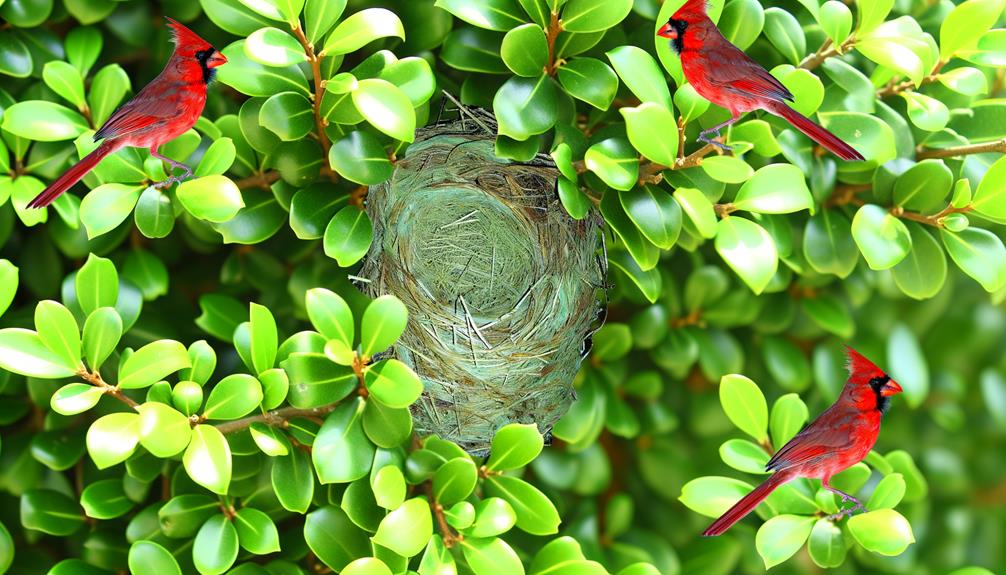
Key Takeaways
- Cardinals do not typically reuse their nests for subsequent broods.
- After fledging, cardinals often construct new nests for each breeding attempt.
- Reusing nests can increase risks of parasites or predators.
- Female cardinals build fresh nests using new materials each time.
- Cardinals' preference for new nests ensures better protection for their young.
Cardinal Nesting Habits
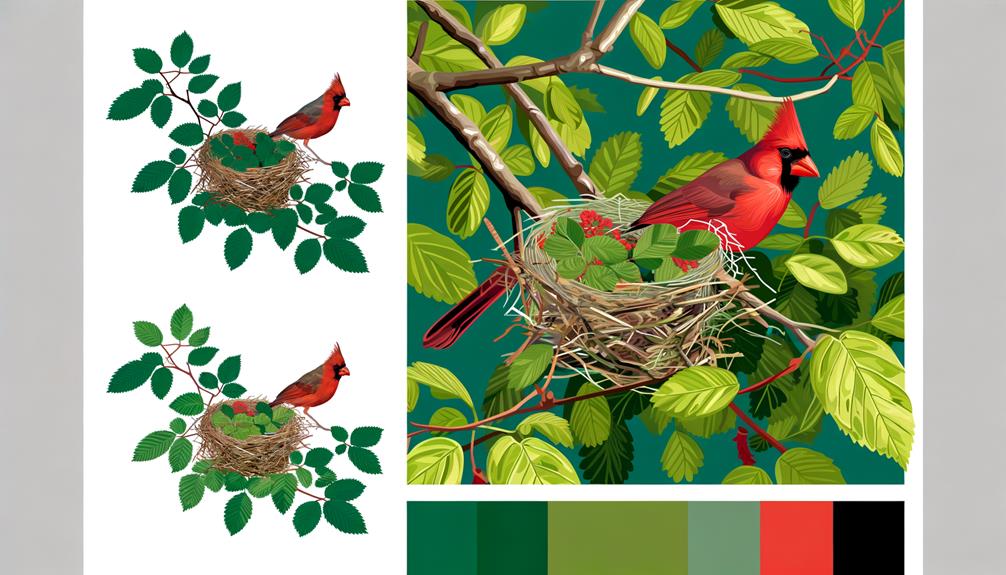
Cardinals display distinct nesting habits, often opting for dense shrubs or low tree branches to construct their nests. You'll observe they choose sites offering ample cover, guaranteeing protection from predators.
Nest construction entails the female cardinal carefully weaving twigs, leaves, and grass to create a robust structure. She may also line the interior with softer materials like hair or moss for added comfort. These nests are usually cup-shaped and well-concealed within the foliage.
The male cardinal aids in gathering materials, although the actual construction is mainly the female's responsibility. This allocation of tasks ensures efficiency and security for their young.
Typical Nesting Sites
You'll find that cardinals typically choose nesting sites in dense shrubs or low tree branches, providing ample cover from predators.
They prefer tree species like dogwoods, maples, and pines for their nests.
Nest height generally ranges from 1 to 15 feet off the ground, depending on the availability of suitable vegetation.
Common Nest Locations
When observing cardinal nesting behavior, you'll often find their nests tucked away in dense shrubs, small trees, or thick garden plants, providing both concealment and protection. Cardinals choose locations with ample foliage to shield their nests from predators and harsh weather.
You might spot these nests 1 to 15 feet above the ground, strategically placed to balance accessibility and safety. Cardinals prefer areas with a mix of open space and dense vegetation, ensuring food availability and cover. By selecting these spots, they maximize the chances of raising their young successfully.
Your garden, if it contains suitable plant cover, can become a potential nesting site, contributing to the vibrant ecosystem cardinals help maintain.
Preferred Tree Species
Many cardinal nests are often found in tree species such as dogwoods, maples, and pines, which provide ideal structural support and dense foliage.
You'll notice that these trees offer a perfect combination of stability and camouflage, crucial for safeguarding cardinal eggs and fledglings from predators.
Dogwoods have dense, intricate branches that provide concealment, while maples offer broad leaves, creating a strong canopy.
Pines, with their evergreen needles, guarantee year-round coverage and protection.
This selection of trees not only offers physical support but also contributes to the cardinals' nesting success by providing a diverse range of feeding opportunities.
When observing cardinal nesting habits, focus on these tree species to comprehend their ecological preferences and behaviors better.
Nest Height Preferences
Cardinals typically construct their nests at heights ranging from 3 to 10 feet above the ground, favoring low to mid-level branches that provide easy access and adequate concealment.
You'll notice that they prefer dense shrubs, small trees, and thickets, offering both security and a strategic vantage point.
Their nesting sites are often situated in areas with abundant foliage, which aids in disguising the nest from predators.
They select locations with ample cover, such as bushes like honeysuckle and grapevines, or deciduous trees like dogwoods and maples.
By choosing these specific nesting heights and sites, cardinals maintain a balance between protection and mobility, crucial for feeding and safeguarding their young.
This nesting behavior underscores their adaptability and strategic nesting selections.
Nest Construction Process
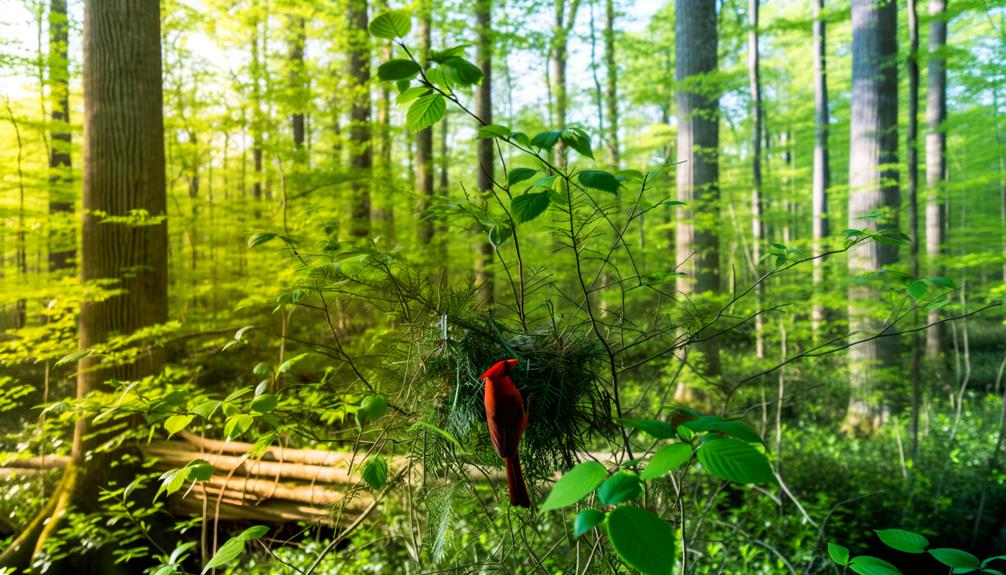
The nest construction process involves meticulous selection of materials like twigs, leaves, and grasses, woven intricately to create a sturdy foundation. You'll observe that cardinals prefer to use flexible materials, ensuring the nest can withstand various weather conditions.
Both the male and female actively participate, with the female typically taking the lead. She shapes the nest's interior, pressing her body against it to form a cup-like structure. The male supports by gathering materials.
Together, they create a well-insulated nest, providing ideal conditions for egg incubation. The construction usually takes three to nine days, reflecting their commitment to creating a safe breeding environment. Their precision and cooperation highlight an impressive natural engineering feat.
Seasonal Nest Usage
Once the meticulously constructed nest is complete, you'll find that its usage is influenced by the changing seasons.
During the breeding season, which typically occurs from March to August, cardinals are highly active in nest building and usage. They'll often build new nests for each brood, rarely reusing old ones within the same season. This behavior guarantees a clean and parasite-free environment for the growing chicks.
Outside the breeding season, cardinals don't use nests for roosting. Instead, they seek dense foliage or evergreen trees for shelter. The seasonal shift from nesting to roosting sites highlights the cardinals' adaptability and resourcefulness, securing their survival and reproductive success amid varying environmental conditions.
Factors Influencing Nest Reuse
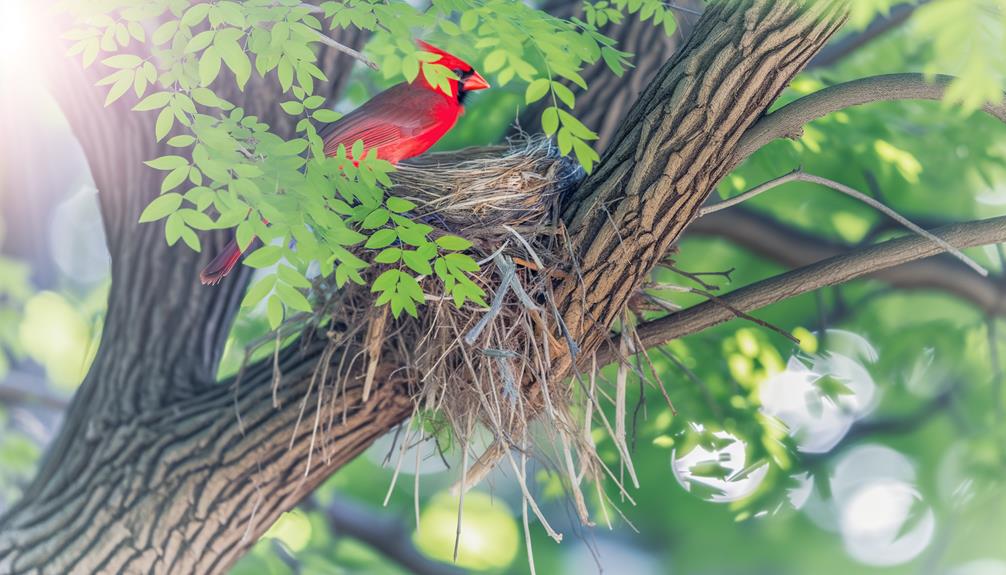
Several environmental and biological factors directly influence whether a cardinal will choose to reuse a nest. Temperature variations can impact the structural integrity of the nest, making it less appealing for reuse. Moreover, the availability of suitable nesting materials plays a pivotal role; if resources are abundant, cardinals might opt to build a new nest.
Vegetation density around the nest site can also affect their decision, as thicker foliage provides better camouflage and protection against the elements. Additionally, the cardinal's health and reproductive cycle influence nest reuse. A healthy bird in peak breeding condition is more likely to build anew, whereas those under stress or in poor health may prefer the convenience of an existing nest.
Predators and Nest Safety
Predation pressure greatly influences a cardinal's decision to reuse a nest, as safety from predators is crucial for the survival of their offspring.
You'll find that cardinals face threats from a variety of predators, including snakes, raccoons, and hawks. These predators can easily locate a reused nest due to scent trails and visible wear. As a result, cardinals often choose to build new nests in different locations to guarantee their young are less detectable.
Additionally, reusing a nest can attract parasitic insects that further endanger the fledglings. The instinct to avoid predation compels cardinals to opt for fresh nesting sites, improving their offspring's chances of survival. This behavior underscores the importance of nest safety in their reproductive strategy.
Observations From Birdwatchers
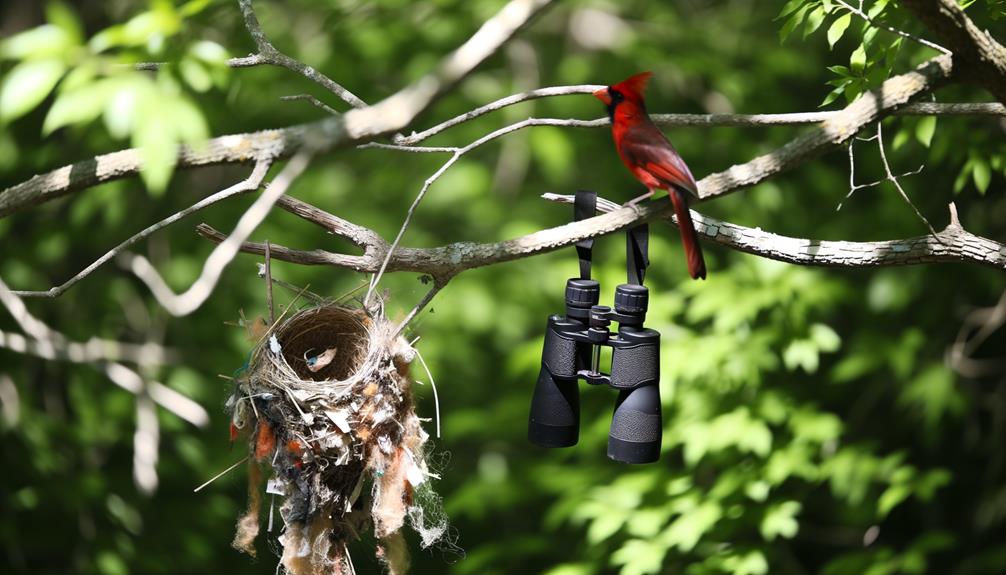
Birdwatchers often report that cardinals rarely reuse their nests, instead opting to build new ones for each breeding season. This behavior likely stems from concerns over nest safety and parasite management. Observations indicate that cardinals prefer to construct their nests in dense shrubs or low trees, ensuring better protection and concealment. You might notice them using various materials like twigs, grass, and leaves.
Here's a detailed table summarizing key observations:
| Observation | Description | Implication |
|---|---|---|
| Nest Reuse | Rarely reused | Enhanced safety and hygiene |
| Preferred Location | Dense shrubs or low trees | Better protection and concealment |
| Nesting Materials | Twigs, grass, leaves | Availability and suitability |
These consistent patterns underscore cardinals' adaptability and meticulous nature in nest-building.
Encouraging Cardinal Nesting
To encourage cardinals to nest in your yard, you should strategically choose sheltered, elevated locations for nest sites. Providing nesting materials like twigs and grass can help them build sturdy nests.
It's also important to secure a safe environment by minimizing the presence of predators and human disturbances.
Choosing Nesting Locations
Selecting the ideal nesting location is vital for cardinals, as it directly impacts their reproductive success and chick survival rates. You'll find that cardinals prefer dense shrubbery or thick foliage, which provides ample cover from predators and harsh weather. They often choose spots 3 to 10 feet above ground, ensuring both accessibility and safety. Proximity to food and water sources is also pivotal, as it reduces the energy expenditure required for feeding.
Here's a quick reference to cardinal nesting preferences:
| Factor | Cardinal Preference |
|---|---|
| Vegetation Type | Dense shrubs, thick foliage |
| Nest Height | 3 to 10 feet above ground |
| Proximity to Resources | Near food and water |
Understanding these preferences helps you create an inviting habitat, encouraging cardinals to nest nearby.
Providing Nesting Materials
Providing the appropriate nesting materials can greatly enhance your chances of attracting cardinals to your garden. Cardinals prefer materials like twigs, grass, pine needles, and leaves. You can gather these items and place them in accessible areas around your yard.
Additionally, consider adding soft materials such as cotton or pet fur, which cardinals use to line their nests for added comfort. By offering a variety of materials, you cater to the cardinals' nesting preferences and increase the likelihood of them choosing your garden.
Be sure these materials remain dry and free from chemicals to maintain their appeal. Your proactive approach in supplying these resources can significantly influence the cardinals' nesting decisions, promoting a thriving avian habitat.
Ensuring Safe Environment
Creating a safe environment is crucial for encouraging cardinals to nest in your garden. You should minimize potential threats and disturbances. Guarantee a plentiful supply of food and water and maintain dense, thorny shrubs where cardinals can hide from predators. Consider the following table for critical actions:
| Action | Description | Effect |
|---|---|---|
| Remove Predators | Keep cats and other predators at bay | Increases safety |
| Provide Water Sources | Install birdbaths or small ponds | Encourages hydration |
| Plant Dense Shrubs | Use native, prickly plants | Offers protection and nesting spots |
| Maintain Quiet Zones | Reduce noise and human activity | Creates a stress-free environment |
Conclusion
So, while cardinals typically don't reuse their nests, understanding their habits can help you encourage nesting in your area. They prefer safe, secluded spots and often build new nests each season.
Keep an eye out like a 19th-century naturalist with binoculars, and you'll notice how predators and environmental factors influence their choices.
By providing a safe environment, you can foster these vibrant birds' presence, ensuring their continued visits to your garden.


